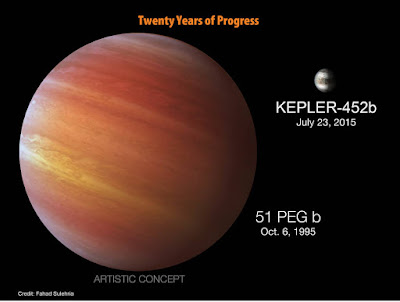At long last, we've found yet another planet that suggests
that we're not alone!
Trust me, it's not enough that we're making plans to visit
Mars, reality TV style as reported in my blog article
entitled “@MIT
Study on Mars One - Why Staying Alive for 68 Days Eating Vegetables means
Oxygen has a License to Kill”.
Now, NASA (National Aeronautical Space Administration) has
announced on Thursday July 23rd 2015 that they’ve found yet another
Earth like planet.
This is the planet Kepler-452b, located 1,400 Light Years
away in the constellation Cygnus a reported in the article “NASA: This
planet is the closest thing to Earth yet”, published July 23, 2015 by Eric
Mack, CNET News.
 |
The discovery was made by NASA scientists as they sifted
through the tons of Data that had been retrieved from the Kepler Space
Telescope. In addition to the discovery
of Kepler-452b, which is the first planet from the star Kepler-452, they also
announced twelve (12) new exoplanets that have almost the same size and
consistence as our Earth.
Of these twelve (12), nine (9) of them orbit stars that are
similar to our Sun, NASA is yet to confirm these stars and their exoplanets. So
far, Kepler-452b has what it takes to support life:
1. Right
Size planet made of Rock based on its location
2. Right
distance from its Sun, in the “Goldilocks Zone”
3. Right
type of Star putting out the same level of radiation
So what did the NASA scientists find that has them so
excited? Potentially Earth 2.0
NASA discovers
Kepler-452b in the Constellation Cygnus – Tickets to Kepler-452b, please
Kepler-452b is located 1,400 Light Years away in the
Constellation Cygnus.
Already there are tickets available to make the trip on the
Chinese website Taobao costing a mere US$0.03 as reported in the article “Tickets
to Earth 'cousin' Kepler-452b now on sale”, published July 30, 2015 by Eric Mack, CNET News.
All this hoopla reminds me of NASA's discovery of the
exoplanet Kepler-186f orbiting an M dwarf Star Kepler-186 in the Constellation
Cygnus on Thursday April 17th 2014 as reported in my blog article
entitled “@NASA
discovers Earth-like exoplanet Kepler-186f in the Constellation Cygnus - 500
light years is awfully far distance to
buy beachfront property”.
 |
It's been twenty (20) years since the discovery of the first
exoplanet 51 Pegasi b. of the 4,660 stars with possible planets found, only
1,029 have been confirmed over this time as having a planet.
Kepler-452b is the 12th known habitable exoplanet
and is special as it’s the most Earth-like discovered so far. Truly, this
exoplanet may harbour intelligent life, being as it's a lot like home.
 |
There are many other notables such as Gliese 832 c that
orbits the Red Dwarf Star Gliese 832 some 16.1 Light years away in the in the
Constellation Grus as reported in my blog article
entitled “Dr.
Robert Wittenmyer Team discovers Gliese 832 c – Supersize my Exoplanet Please
with a Serving of Super-Venus”.
Based on the analysis of the Kepler space Telescope Data,
Kepler-452b, being the second planet from its sun Kepler-452, is most likely a
rocky planet like out Earth.
Kepler-452b is
Earth 2.0 – Home Sweet home but with a Stronger Gravity
It's about 60% bigger than the Earth, making its gravity a
little strong then what we're used to on Earth. Its orbit around the sun
Kepler-452 is eerily similar to Earth.
It makes a complete orbit every 385 days, just twenty (20)
days longer than Earth 365 days as reported in the article “NASA
Has Discovered a Planet That Seems a Lot Like Earth”, published July 23,
2015 by Eric Roston, Bloomberg News.
It's in the right location from its sun Kepler-452, making
it possible that it has liquid water on its surface. Thus life is possible,
albeit it might still have active volcanoes like our Earth, but with a slightly
thicker atmosphere due to its stronger gravity.
 |
The life on the planet may be very advanced but short and
stocky and very muscular, being as they've had a 1.5 billion year head start on
Earth under such a strong gravitational force.
It's sun Kepler-452, being 1.5 billion years older than our
Sun which is about 6 billion years, puts out the same amount of light and has
the same surface temperature and mass based on Infrared spectroscopy.
This suggests it may have a more violent past but mellowed
over time, resulting in its first planet having a chance to develope life due
to its evolutionary head start.
So how advanced would they be?
And does it make sense contacting them as Professor Stephen
Hawking is hell-bent on doing as noted in the article “Stephen
Hawking launches $100m search for alien life beyond solar system”,
published Tuesday 21 July 2015, by Ian Sample, The UK Guardian?
To Kepler-452 from
Earth with Love - Why the Fermi Paradox means contacting isn't a good idea
So why not send a message to them?
Well, it they're very advanced, they might not take kindly
to being hailed and that’s even if they can understand our messages. If they
do, they may just come and annihilate us, albeit the Fermi Paradox both
supports this idea and then rules it out.
Plus at 1,400 Light Years, we just don't have the Technology
to even say hello, let alone set up a colony or invade their territory. Heck,
they may have even left the planet or died out a long time ago as the light
we’re seeing is from the past, with a lag time of 1,400 years.
Worse, they may be a super species, uninterested in contact
and exploration and existing in a state of suspended animation powered by a
Dyson Sphere.
Still, it helps to know that potentially, we're not alone!
Awaiting more News from NASA on the other nine (9) candidates from the Kepler
System that might harbour life!
Here’s
the link:
NASA Twitter Feed: @NASA
No comments:
Post a Comment